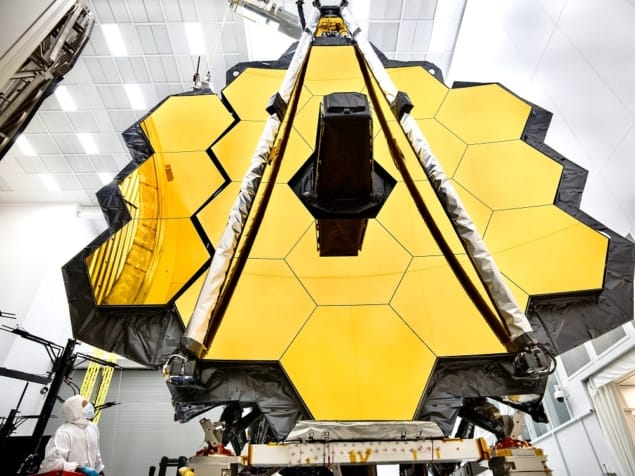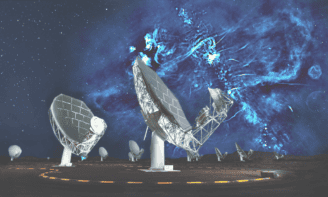
NASA has announced that the James Webb Space Telescope (JWST) will be launched on 30 March 2021, delaying the mission by a year. The postponement will add another $800m to the cost of the craft, boosting it to $8.8bn. This extra cash will first have to be agreed by the US Congress, which in 2011 capped the cost of the JWST at $8bn.
A report by the US Government Accountability Office (GAO) in February stated that the JWST was unlikely to meet its then launch date of 2019. Engineers at Northrop Grumman Aerospace Systems in California – the main contractor involved in building the telescope – had been grappling with a number of issues such being able to safely deploy the craft’s huge 21 x 14 m sunshield without tearing the ultrathin fabric. NASA delays James Webb Space Telescope
In March, NASA announced that the launch would be put back to May 2020 at the earliest and established an independent review board, chaired by NASA veteran Thomas Young, to investigate the impact of the delays. In the 63-page report, released yesterday, the independent review board discovered a number of technical issues that have hit the development schedule, including human errors. That includes using the wrong solvent to clean fuel valves and not tightening the sunshield’s fasteners properly, which keep it furled up before the craft reaches space.
The report offers several recommendations, which NASA already has or will implement, including bringing in a “world-class” system engineer as a dedicated commission manager who would already have the experience and technical knowledge of the JWST’s design. “Webb is vital to the next generation of research beyond NASA’s Hubble Space Telescope,” notes NASA Administrator Jim Bridenstine. “Despite major challenges, the board and NASA unanimously agree that Webb will achieve mission success with the implementation of the board’s recommendations, many of which already are underway.”
Analysis: a decade of disappointment
The launch of the James Webb Space Telescope (JWST) was starting to feel within touching distance. Set to blast off next year, excitement was brewing in the community with astronomers writing proposals for observing time on the JWST’s four scientific instruments. But following the telescope’s delay until March 2021, once again it feels a distant prospect.
Initially expected to cost $500m with a launch date of 2007, since then the JWST has had its departure rescheduled on more than 10 separate occasions. To adapt a term widely used by critics of nuclear fusion, the launch always seems a year away and who is to say that it won’t be postponed yet again. And while the US Congress capped the cost of the mission at $8bn, that limit has now been smashed – costs set are to rise by a massive $800m with NASA force to take its begging bowl to Congress.
The engineering challenge to build the JWST is huge. The behemoth can easily be categorized as a “civilization-class” mission – pushing the forefront of engineering. The JWST’s sunshield, for example, which keeps the instruments cool and in a stable environment, is a massive 20 × 14 m while its 6.5 m mirror is made up of 18 hexagonal segments, giving the telescope a collecting area of 25 m2. Both the mirror and the sunshield are folded away for launch and will then unfurl following take-off.
NASA has been burnt before when launching similar civilization-class projects. Weeks after the Hubble telescope was launched in April 1990, images from it were blurred. The culprit was spherical aberration due to the telescope’s primary mirror having been polished to the wrong shape. Given that Hubble was in orbit around the Earth, astronauts were fortunately able to repair the probe in December 1993.
But it still wasn’t easy – it took 11 days and five space walks, a record at the time. Like Hubble, the JWST is expected to open a new vista on the cosmos. Yet the problem for NASA is that the JWST will instead be placed at Lagrange Point 2 – a place 1.5 million kilometres from Earth in the opposite direction to the Sun. No astronauts will be making a trip there if the telescope encounters any problems.
Space science has seen some incredibly successful and daring missions in recent years, including the landing of the Curiosity rover on Mars in 2012 and the European Space Agency’s Philae lander touching down on comet 67P/Churyumov–Gerasimenko in 2014. The JWST will add to that list. Given the amount of money already spent and the delays, NASA can’t afford to get it wrong. This is especially so if the agency wants Congress on its side to fund future large scale missions such as the Wide Field Infrared Survey Telescope, which US president Donald Trump has already tried to defund in his 2018 budget request.
The JWST is a mission too big to fail. It seems wise to delay the launch until NASA can do all it can to make it a success. The question is, what impact will all these delays and cost overruns be for future programmes?



